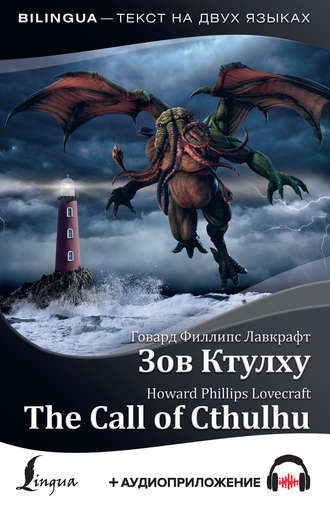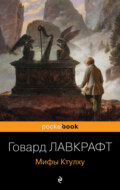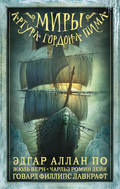
Говард Филлипс Лавкрафт
The Call of Cthulhu / Зов Ктулху (+ аудиоприложение)
2-го апреля примерно в 3 часа дня все признаки болезни Уилкокса внезапно исчезли. Он вертикально сел в кровати, удивлённый, что оказался дома, и полностью неосведомлённый о том, что случилось во сне или наяву, начиная с ночи 22-го марта. Его врач объявил о выздоровлении, и юноша через три дня вернулся к себе домой; но помочь профессору Энджеллу он был не в состоянии. С выздоровлением все следы странных сновидений исчезли, и спустя неделю после бессмысленных и заурядных видений мой дядя больше не вёл записей ночных образов.
Здесь первая часть рукописи заканчивалась, но она дала мне много материала для размышлений. В записках содержались описания снов различных людей, относящихся к тому самому периоду, когда происходили странные визиты молодого Уилкокса. Мой дядя, кажется, опросил почти всех своих друзей, к которым мог обратиться, прося рассказать их о своих снах, и фиксируя даты любых значимых за последнее время видений. Он получил так много откликов, что справиться с ними без секретаря было невозможно. Эта оригинальная корреспонденция не сохранилась, но его заметки составляли полный и действительно важный отчёт. Средние люди в обществе и бизнесе давали почти полностью отрицательный результат, хотя и были среди них некоторые несформированные ночные видения в период между 23 марта и 2 апреля – во время бреда молодого Уилкокса. Четыре случая давали неясные описания странных пейзажей, а в одном случае было упомянуто нечто вызывающее страх.
Ответы художников и поэтов были самыми интересными, и я подозреваю, что если бы сопоставили эти рассказы, то возникла бы паника. Но это были не оригинальные записи, и я подозревал, что им задавали наводящие вопросы – или же записи были отредактированы. Именно поэтому я продолжал думать, что Уилкокс оказал на старика-учёного внушающее воздействие. Ответы эстетов содержали тревожные рассказы. Большая часть их с 28 февраля до 2 апреля видела во сне очень причудливые вещи, интенсивность сновидений была несоизмеримо сильнее в период бреда скульптора. Больше четверти из них сообщали о сценах и полузвуках, подобных тем, что описывал Уилкокс; а некоторые из видевших сны боялись гигантской безымянной твари, которая в конце стала видимой. Один случай был весьма печальным. Широко известный архитектор, проявлявший большой интерес к теософии и оккультизму, в день начала болезни молодого Уилкокса впал в буйное помешательство, на протяжении нескольких месяцев непрерывно кричал, звал на помощь, чтобы его спасли от какого-то сбежавшего обитателя ада. Если бы мой дядя вместо чисел упомянул настоящие имена, то я бы провёл собственное расследование; но дело обстояло так, что мне удалось проследить лишь несколько случаев. И хорошо, что до тех людей не дошли никакие объяснения.
Статьи из газет, как я выяснил, касались случаев паники, мании и чудачеств во время указанного периода. Коллекция профессора Энджелла была огромной, а источники были рассредоточены по всему земному шару. Здесь было ночное самоубийство в Лондоне, когда человек с диким криком выпрыгнул из окна. Здесь было письмо редактору газеты в Южной Америке, в котором некий фанатик на основании своих видений предсказывал будущее. Статья из Калифорнии описывала колонию теософов: люди в белых одеждах готовились к какому-то «великолепному исполнению», которое так и не наступило. Статьи из Индии говорили о серьёзных волнениях среди местного населения в ночь с 22-го на 23-е марта. Запад Ирландии был также полон диких слухов и легендарных историй, а живописец по имени Ардуа-Бонно, изображавший фантастические сюжеты, на весеннем парижском салоне в 1926-м году предложил богохульный «Пейзаж из сна». Также были зафиксированы многочисленные беспорядки в психиатрических лечебницах. Но я был тогда убеждён, что молодой Уилкокс знал о более ранних материалах, упомянутых профессором.
II. The Tale of Inspector Legrasse
The older matters which had made the sculptor’s dream and bas-relief so significant to my uncle formed the second half of his long manuscript. Once before, it appears, Professor Angell had seen the hellish outlines of the nameless monstrosity, thought about the unknown hieroglyphics, and heard the ominous syllables which can be written only as “Cthulhu”.
It was in 1908, seventeen years before, when the American Archaeological Society held its annual meeting in St. Louis. Professor Angell, due to his authority and attainments, had a prominent part in it. Other people offered him questions for correct answering and problems for expert solution.
There was a middle-aged man who had travelled all the way from New Orleans to get special information unobtainable from any local source. His name was John Raymond Legrasse, and he was an Inspector of Police. He brought the subject of his visit, a grotesque, repulsive, and apparently very ancient stone statuette whose origin was unknown.
Inspector Legrasse had the least interest in archaeology. He was prompted by purely professional considerations. The statuette, idol, fetish, or whatever it was, had been captured some months before in the wooded swamps south of New Orleans during a raid on a supposed voodoo meeting. And the rites connected with it were so singular and hideous, that the police treated it as a dark cult totally unknown to them, and infinitely more diabolic than even the blackest of the African voodoo circles. Absolutely nothing was discovered of its origin: only erratic and unbelievable tales from the captured members; hence the police wanted to learn something which might help them to place the frightful symbol, and through it understand the cult itself.
Inspector Legrasse was not prepared for the sensation which his offering created. One sight of the thing had been enough to throw the assembled scientists into a state of tense excitement. They crowded around him to gaze at the diminutive strange figure, apparently very old and unknown. Strange school of sculpture had animated this terrible object, yet centuries and even thousands of years seemed recorded in its dim and greenish surface of stone.
The figure, which was finally passed slowly from man to man for close and careful study, was between seven and eight inches in height. It represented a vaguely anthropoid monster, with an octopus-like head, whose face was a mass of feelers, a scaly, rubbery-looking body, prodigious claws on hind and fore feet, and long, narrow wings behind. This thing, which was an embodiment of a fearsome and unnatural malignancy, squatted evilly on a rectangular block or pedestal covered with undecipherable characters. The tips of the wings touched the back edge of the block, the seat occupied the centre, while the long, curved claws of the hind legs gripped the front edge and extended toward the bottom of the pedestal. The cephalopod head was bent forward, so that the ends of the facial feelers brushed the backs of huge fore paws which clasped the elevated knees. The creature looked abnormally life-like and fearful because its source was totally unknown. Its vast, awesome, and incalculable age was unmistakable; but it was not connected to any known type of art belonging to civilisation’s youth – or indeed to any other time. Even its material was a mystery; for the soapy, greenish-black stone with its golden or iridescent flecks and striations resembled nothing familiar to geology or mineralogy. The characters along the base were totally unknown; and nobody could form the least notion of even their remotest linguistic kinship. They, like the subject and material, belonged to something horribly remote and distinct from mankind as we know it.
And yet, as the members shook their heads and confessed defeat at the Inspector’s problem, there was one man in that gathering who recognized bizarre familiarity in the monstrous shape and writing. This person was the late William Channing Webb, Professor of Anthropology in Princeton University, and a famous explorer.
Professor Webb had been engaged, forty-eight years before, in a tour of Greenland and Iceland in search of some Runic inscriptions. On the West Greenland coast he had met a singular tribe or cult of degenerate Esquimaux whose religion, a curious form of devil-worship, frightened him with its deliberate bloodthirstiness and repulsiveness. It was a faith of which other Esquimaux knew little, and which they mentioned only with shudders, saying that it had come down from horribly ancient ages before the world was made. Besides nameless rites and human sacrifices there were certain queer hereditary rituals addressed to a supreme elder devil or tornasuk; and of this Professor Webb had taken a careful phonetic copy from an aged angekok or wizard-priest, expressing the sounds in Roman letters as best he knew how. The most important thing was the fetish, around which they danced when the aurora leaped high over the ice cliffs. It was, the professor stated, a very crude bas-relief of stone, comprising a hideous picture and some cryptic writing. And it was a rough parallel in all essential features of the bestial thing now lying before the meeting.
This data, received with suspense and astonishment by the assembled members, was very exciting to Inspector Legrasse, and he at once began to ply his informant with questions. He noted and copied an oral ritual among the swamp cult-worshippers which his men had arrested. So he asked the professor to remember the syllables that he had heard from the diabolist Esquimaux. There then followed an exhaustive comparison of details, and a moment of silence when both detective and scientist agreed on the identity of the phrase common to two hellish rituals. What both the Esquimaux wizards and the Louisiana swamp-priests had chanted to their kindred idols was something very like this:
“Ph’nglui mglw’nafh Cthulhu R’lyeh wgah’nagl fhtagn.”
Legrasse said that some his mongrel prisoners had told him the meaning of these words. This text, as given, ran something like this:
“In his house at R’lyeh dead Cthulhu waits dreaming.”
And now Inspector Legrasse related as fully as possible his experience with the swamp worshippers. This is the story to which my uncle attached profound significance. It was the wildest dream of a myth-maker or a theosophist.
On November 1st, 1907, frantic summons came to the New Orleans police from the swamp and lagoon country to the south. The people there, mostly primitive but good-natured descendants of Lafitte’s men, were in stark terror from an unknown thing which had occurred in the night. It was voodoo, apparently, but voodoo of a more terrible sort than they had ever known; and some of their women and children had disappeared since the malevolent tom-tom had begun its incessant beating far within the black haunted woods where no one walked. There were insane shouts and harrowing screams, soul-chilling chants and dancing devil-flames; and, the frightened messenger added, the people could stand it no more.
So twenty police officers in two carriages and an automobile went there with the shivering squatter as a guide. At the end of the road they walked for miles in silence through the terrible cypress woods where day never came. Ugly roots and malignant hanging nooses of Spanish moss beset them. Finally, the squatter settlement, a miserable huddle of huts, hove in sight; and hysterical dwellers ran out. The beat of tom-toms was now faintly audible far, far ahead; and a curdling shriek came when the wind shifted. The squatters refused to go toward the scene of unholy worship, so Inspector Legrasse and his nineteen colleagues went into black arcades of horror.
The region they entered was one of traditionally evil repute, white men normally did not enter it. There were legends of a hidden lake, in which dwelt a huge, formless white polypous thing with luminous eyes; and squatters whispered that bat-winged devils flew up out of caverns in inner earth to worship it at midnight. They said it had been there before the Indians, and before even the beasts and birds of the woods. It was nightmare itself, and to see it was to die. But it came to them in dreams, and so they knew enough not to go there. The present voodoo orgy was, indeed, on the fringe of this area, but that location was bad enough; hence perhaps the very place of the worship had terrified the squatters more than the shocking sounds and incidents.
Legrasse’s men ploughed on through the black morass toward the red glare and muffled tom-toms. There are sounds made by men, and sounds made by beasts; and it is terrible to hear when the sources change. The voices the policemen heard were like pestilential tempests from the gulfs of hell. From time to time a chorus of hoarse voices chanted that hideous phrase or ritual:
“Ph’nglui mglw’nafh Cthulhu R’lyeh wgah’nagl fhtagn.”
Then the men reached a spot where the trees were thinner. Four of them reeled, one fainted, and two were shaken into a frantic cry. Some stood trembling and nearly hypnotized with horror.
In a natural glade of the swamp stood a grassy island of an acre’s extent, clear of trees and dry. On this now leaped and twisted indescribable horde of humans. Totally naked, this hybrid spawn were braying, bellowing, and writhing about a monstrous ring-shaped bonfire; in the centre of which stood a great granite monolith some eight feet in height, on top of which rested the noxious carven statuette. From a wide circle of ten scaffolds set up at regular intervals hung, head downward, the marred bodies of the helpless squatters who had disappeared. Inside this circle the ring of worshippers jumped and roared, from left to right in endless bacchanal between the ring of bodies and the ring of fire.
It may be only imagination, but a Spanish man heard antiphonal responses to the ritual from some far and unillumined spot within the wood. This man, Joseph D. Galvez, I later met and questioned. He said that he heard beating of great wings, and saw a glimpse of shining eyes and a mountainous white bulk beyond the remotest trees but I suppose he was a little superstitious.
But duty came first; and the police relied on their firearms and went determinedly into the nauseous rout. For five minutes the chaos was beyond description. Shots were fired, and escapes were made; but in the end Legrasse was able to count forty-seven sullen prisoners, to whom he ordered to dress and fall into line between two rows of policemen. Five of the worshippers lay dead, and two were severely wounded. Of course, Legrasse took the statuette from the monolith.
After a trip, the prisoners were examined. They were men of a very low, mixed-blooded, and mentally aberrant type. Most were seamen, some negroes and mulattoes, largely West Indians or Portuguese from the Cape Verde Islands. But before many questions were asked, it became clear that something far deeper and older than negro fetishism was involved.
They worshipped, so they said, the Great Old Ones who lived ages before there were any men, and who came to the young world out of the sky. Those Old Ones were gone now, inside the earth and under the sea; but their dead bodies had told their secrets in dreams to the first men, who formed a cult which had never died. This was that cult, and the prisoners said it had always existed and always would exist, hidden in distant and dark places all over the world until the time when the great priest Cthulhu, from his dark house in the mighty city of R’lyeh under the waters, would rise and rule the Earth. Some day he will call, when the stars are ready, and the secret cult will always be waiting to liberate him.
Meanwhile no more can be told. There was a secret which could not be extracted. Mankind was not absolutely alone among the conscious things of earth: some shapes came out of the dark to visit the faithful few. But these were not the Great Old Ones. No man had ever seen the Old Ones. The carven idol was great Cthulhu, but nobody might say how the others looked like. No one could read the old writing now, but things were told by word of mouth. The chanted ritual was not the secret – that was never spoken aloud, only whispered. The chant meant only this: “In his house at R’lyeh dead Cthulhu waits dreaming.”
Only two of the prisoners were found sane enough to be hanged, and the rest were taken to various hospitals. All denied ritual murders, and said that the killing had been done by Black Winged Ones which had come to them from their immemorial meeting-place in the haunted wood. And nothing more could be known. What the police learned came mainly from the immensely aged mestizo named Castro, who said that he had sailed to different ports and talked with undying leaders of the cult in the mountains of China.
Old Castro remembered bits of hideous legend that made man and the world seem recent and transient indeed. There had been ages when other Creatures ruled on the Earth, and They had had great cities. Remains of Them, the deathless Chinamen had told him, could still be found as Cyclopean stones on islands in the Pacific. They all died long ago before men came, but there were ways which could revive Them when the stars had come round again to the right positions in the cycle of eternity. They had, indeed, come themselves from the stars, and brought Their images with Them.
These Great Old Ones, Castro continued, were not composed altogether of flesh and blood. They had shape but that shape was not made of matter. When the stars came round to the right positions, They could travel from world to world through the sky; but when the stars were wrong, They could not live. But although They no longer lived, They would never really die. They all lay in stone houses in Their great city of R’lyeh, preserved by the spells of mighty Cthulhu for a glorious resurrection when the stars and the Earth might once more be ready for Them. But at that time some force from outside must serve to liberate Their bodies. The spells prevented Them from making an initial move, and They could only lie awake in the dark and think while millions of years passed by. They knew all that was occurring in the universe, for Their mode of speech was transmitted thought. Even now They talked in Their tombs. When, after infinities of chaos, the first men came, the Great Old Ones spoke to the sensitive among them by moulding their dreams; for only thus could Their language reach the fleshly minds.
Then, whispered Castro, those first men formed the cult around tall idols which the Great Ones showed them; idols brought in dim eras from dark stars. That cult would never die till the stars came right again, and the secret priests would take great Cthulhu from His tomb to revive His servants and resume His rule of Earth. This time would be easy to know, for then mankind would become as the Great Old Ones; free and wild and beyond good and evil, with laws and morals thrown aside. And all men would be shouting and killing and revelling in joy. Then the liberated Old Ones would teach them new ways to shout and kill and revel and enjoy themselves, and all the Earth would flame with a holocaust of ecstasy and freedom. Meanwhile the cult, by appropriate rites, must keep alive the memory of those ancient ways and tell about their return.
In the elder time chosen men had talked with the entombed Old Ones in dreams, but then something happened. The great stone city R’lyeh, with its monoliths and sepulchres, had sunk beneath the waves; and the deep waters, full of the one primal mystery through which not even thought can pass, had cut off the communication. But memory never died, and the high-priests said that the city would rise again when the stars were right. Then the black spirits of Earth would come out, mouldy and shadowy, and full of dim rumours. But old Castro dared not speak much of them. He became silent hurriedly, and said nothing more. He curiously declined to mention the size of the Old Ones, too. Of the cult, he said that he thought the centre lay amid the pathless desert of Arabia, where Irem, the City of Pillars, dreams hidden and untouched. It was not connected to the European witch-cult, and was virtually unknown beyond its members. No book had ever mentioned it, though the deathless Chinamen said that there were double meanings in the Necronomicon of the mad arab Abdul Alhazred which the initiated might read, especially this couplet:
“That is not dead which can eternal lie,
And with strange ages even death may die.”
Legrasse, deeply impressed, had inquired about the historic affiliations of the cult. Castro, apparently, had told the truth when he said that it was wholly secret. The authorities at Tulane University could say nothing about either cult or image, and now the detective had come to the highest authorities in the country and met with the Greenland tale of Professor Webb.
The great interest aroused at the meeting by Legrasse’s tale is echoed in the correspondence of those who attended; although it was not mentioned in the formal publications of the society. Caution is the first care of scientists who often face charlatanry and imposture. Legrasse lent the image to Professor Webb. When Professor had died, it was returned to him. I viewed it not long ago. It is truly a terrible thing, and akin to the dream-sculpture of young Wilcox.
I did not wonder that my uncle was excited by the tale of the sculptor. Professor Angell started an investigation immediately; though privately I suspected young Wilcox of trickery. He could invent a series of dreams to heighten and continue the mystery. So, after thoroughly studying the manuscript again and correlating the theosophical and anthropological notes with the cult narrative of Legrasse, I made a trip to Providence to see the sculptor and accuse him of imposing upon a learned and aged man.
Wilcox still lived alone in the Fleur-de-Lys Building in Thomas Street, a hideous Victorian imitation of 17th century Breton Architecture. I found him at work in his rooms, and understood at once that his genius is indeed profound and authentic. I believe one day he will be well-known as one of the great decadents; for he has crystallised in clay and in marble those nightmares and phantasies which Arthur Machen evokes in prose, and Clark Ashton Smith makes visible in verse and in painting.
Dark, frail, he asked me about my business without rising. Then I told him who I was, he displayed some interest; for my uncle had excited his curiosity studying his strange dreams, yet had never explained the reason for the study. In a short time I became convinced of his absolute sincerity, for he spoke of the dreams in a manner none could mistake. They had influenced his art profoundly, and he showed me a morbid statue whose contours almost made me shake. He could not recall the original of this thing except in his own dream bas-relief, but the outlines had formed themselves insensibly under his hands. It was, no doubt, the giant shape he had seen in delirium. But he really knew nothing of the hidden cult.
He talked of his dreams in a strangely poetic fashion; making me see the damp Cyclopean city of slimy green stone – whose geometry, he said, was all wrong – and hear with frightened expectancy the ceaseless, half-mental calling from underground: “Cthulhu fhtagn”, “Cthulhu fhtagn.”
These words had formed part of that dread ritual which told of dead Cthulhu’s dream-vigil in his stone vault at R’lyeh, and I felt deeply touched despite my rational beliefs. Wilcox, I was sure, had heard of the cult in some casual way, and had soon forgotten it amidst the mass of his equally weird reading and imagining. Later it had found subconscious expression in dreams, in the bas-relief, and in the terrible statue. The young man was slightly affected and slightly ill-mannered, that type I never liked, but I admit both his genius and his honesty. I wish him all the success his talent promises.







